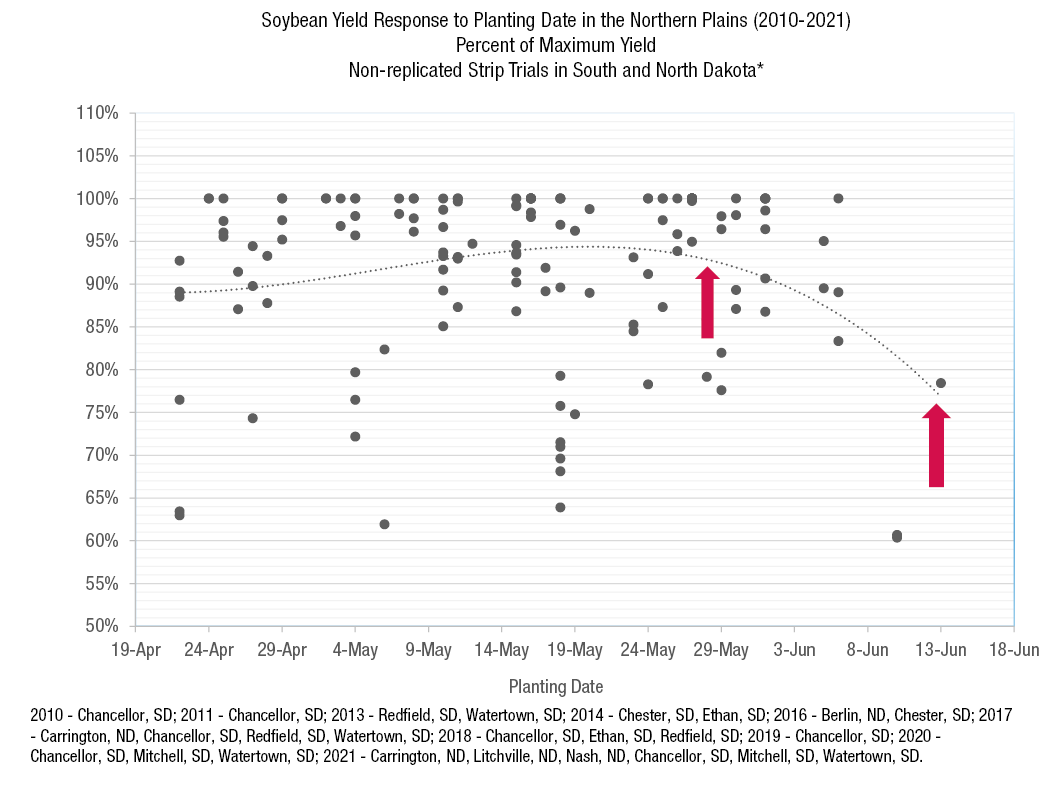
Longitudinal Study: Investigating the Planting Date’s Effect on Soybean Yield Potential in the Northern Plains
Key Findings
- The optimum planting date to maximize soybean yield potential has a larger time frame than corn.
- 10+ years of data supports the widely accepted practice of planting soybean early in the growing season, and waiting for more favorable conditions to begin planting corn (See A Long-Term Research Study Investigating the Effect of Planting Date on Corn Yield Potential and Moisture Content in the Northern Plains).
- The potential to maximize yield at 100% is reduced by 1.0% per day after May 25. Individual locations and years may vary — this data should be used as a guide of recommendations on optimum planting dates.
- Individual locations and years may vary — this data should be used as a guide of recommendations on optimum planting dates.
- Typically, soybean seed can be planted when soil moisture conditions are satisfactory, regardless of soil temperature and forecast.
Trial Objectives
- Understand the risks and rewards of planting soybeans at different times throughout spring.
- Provide guidance on when to plant in order to maximize yield potential.
- Help growers make informed replant decisions when stands are reduced by frost or other stressors.
Research Site Details
- Ongoing trial conducted in the Northern Plains (North and South Dakota) since 2010.
- Data summarizes a smaller data set with limited locations. Values are based on averages and not significantly analyzed.
- While comparing data across years, findings are presented as a percentage of the maximum yield for the year and soybean product.
- Non-replicated strip trial design.
Study Results
- Late April to mid-May proved to have the highest yields, with a steady decline as the season progressed (Figure 1).
- The potential to maximize yield decreased 20% from May 25 to June 15 (a span of 20 days), producing an average daily loss of 1.0% (Figure 1).
Year and Location of Strip Trials
| Year | Location |
|---|---|
| 2010 | Chancellor, SD |
| 2011 | Chancellor, SD |
| 2012 | NA* |
| 2013 | Watertown, SD Redfield, SD |
| 2014 | Chester, SD Ethan, SD |
| 2015 | NA* |
| 2016 | Berlin, ND Chester, SD |
| 2017 | Carrington, ND Chancellor, SD Watertown, SD Redfield, SD |
| 2018 | Chancellor, SD Ethan, SD Redfield, SD |
| 2019 | Chancellor, SD |
| 2020 | Chancellor, SD Mitchell, SD Washburn, ND |
| 2021 | Litchville, ND Nash, ND Carrington, ND Chancellor, SD Watertown, SD Mitchell, SD |
| *No data | |
